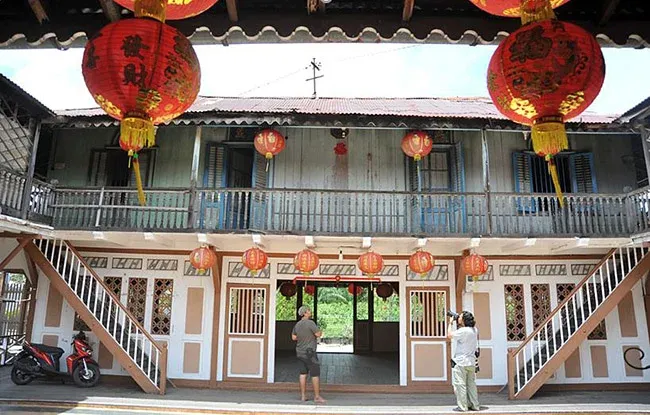 |
| The Tjhia Clan House, Singkawang.Special documentation |
The Tjhia Clan House has evolved into a major tourist attraction, particularly for visitors with a keen interest in history, in Singkawang.
Nestled amidst the lush landscapes of West Kalimantan, the city of Singkawang stands as a testament to the harmonious coexistence of diverse cultures, where the East meets the West and history converges with modernity.
Singkawang’s Chinatown heritage shaped by Chinese migration
Renowned as one of the largest Chinatowns in the region, Singkawang beckons travelers with its rich tapestry of heritage and the intriguing stories that have woven through its streets for centuries.
The tale of Singkawang's heritage unfurls across epochs, with the ebb and flow of immigration crafting a vibrant mosaic of cultural identity.
While the presence of Chinese immigrants can be traced back through the annals of time, it was during the transformative 16th to 18th centuries that waves of settlers from China embarked upon a journey that would lead them to the lands near Singkawang.
Read also The Equator Monument: The Charm Of Pontianak City's Landmark
Budok and Montedrado emerged as key locations, becoming the cradle of a new era as these pioneers delved into the realm of mining, forever intertwining their fate with the city's evolution.
This infusion of Chinese heritage has left an indelible mark on Singkawang, earning it the moniker "City of Amoi." The ethereal charm of its streets, bustling with life and an array of culinary delights, offers a window into the rich tapestry of Amoi culture that prevails among the majority of the population.
Yet, Singkawang's allure transcends the boundaries of ethnicity. Beyond the iconic sobriquet of the "City of a Thousand Temples," a lesser-known facet of the city's identity emerges—an enclave of historical monuments that beckon travelers on a journey of exploration and discovery, immersing them in the world of historical tourism.
Resplendent Tjhia Clan House, 1901 time capsule
Among these treasures stands the resplendent Tjhia Clan House, a veritable time capsule dating back to the dawn of the 20th century, specifically in the year 1901.
This architectural masterpiece stands as a testament to the enduring legacy of Singkawang's cultural heritage, a living testament to the confluence of Eastern and Western influences that have shaped the city's architectural landscape.
Crafted with meticulous care, the Tjhia Clan House seamlessly marries elements of traditional Eastern design with the refined sensibilities of Western architecture, a harmonious embodiment of the city's multicultural identity.
Anchored by the strength of Ironwood, this architectural marvel bears witness to the passage of time while standing strong against its currents.
Stepping through the doors of the Tjhia Clan House is akin to stepping back in time, a journey through the annals of history.
Visitors are greeted by a symphony of ornate carvings, intricate embellishments, and a myriad of historical artifacts, each preserving a fragment of Singkawang's storied past.
It is a place where the whispers of time echo in the corridors, where the stories of generations past find voice through the tangible artifacts that grace the premises.
Read Borneo As A Choice Of Ecotourism And Historical Tourism Destinations
Tjhia Clan House, shared heritage and history
In an era defined by rapid change and modernization, Singkawang's commitment to preserving these cultural treasures stands as a testament to its dedication to honoring its roots.
As the sun sets over the city's bustling streets and the Tjhia Clan House embraces the tranquility of the evening, it remains a beacon of cultural heritage, inviting visitors to delve into its rich narrative and discover the threads that have woven the tapestry of Singkawang's history.
Today, the Tjhia Clan House has evolved into a prominent tourist destination, especially catering to historical enthusiasts in Singkawang.
Here, those with a penchant for history and a deep concern for humanitarian issues can savor more than just the account of Chinese mainland immigrants' migration to Singkawang. They can also immerse themselves in the intricate tapestry of human civilization's global history.
Read Pampang Cultural House, East Kalimantan
The Tjhia Clan House in Singkawang is not exclusively owned by the Chinese community, especially the Hakka people, but is open to all residents without exception.
This house now belongs to everyone, as it represents the richness of tradition, culture, and historical heritage, not just in Singkawang but beyond.












